Canada Remembers Times - 2010 Edition - Page 3
Healing the Troops
Many Canadians have looked after the wounded during war, including Drs. Frederick Banting, Norman Bethune and Cluny Macpherson. Their experiences led to impressive medical discoveries still in use today.
Dr. Cluny Macpherson
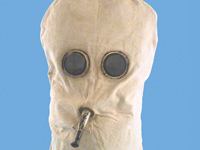
The Macpherson gas mask
Photo: Museum of Health Care at Kingston. Used with permission.
Cluny Macpherson was born in St. John’s, Newfoundland in 1879, and earned his medical degree at McGill University in Montréal. Dr. Macpherson enlisted in September 1914, and was appointed Principal Medical Officer of the 1st Newfoundland Regiment during the First World War. He served in France, Belgium, Egypt, Salonica and Gallipoli, Turkey.
Early in the war, a soldier’s only protection from gas was to breathe through a handkerchief soaked in urine. Dr. Macpherson invented the first gas mask by modifying a helmet with a canvas hood, eyepieces and a breathing tube. This became an important protective device in the war, protecting soldiers from blindness, disfigurement and injury to their throats and lungs.
Dr. Norman Bethune
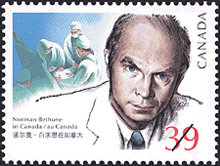
“Norman Bethune in Canada” stamp.
Photo: © Canada Post Corporation. Canadian Postal Archives, LAC, POSTAL 1214
Norman Bethune was born in 1890 in Gravenhurst, Ontario. At the outbreak of the First World War in 1914, he enlisted in the No. 2 Field Ambulance Medical Corps, and served as a stretcher-bearer. Wounded at Ypres, Belgium, he returned to Canada to complete his medical degree in 1916. Bethune later pioneered the world’s first mobile blood transfusion units, established free medical clinics in Montréal, and invented new surgical instruments.
When Japan invaded China in 1937, Dr. Bethune was determined to help. He went there with the Canadian-American Mobile Medical Unit and worked day and night under rudimentary conditions, caring for the wounded. Tales were told across China of this extraordinary foreigner who was undaunted by hardship, and gave his clothes, his food, and even his own blood to those in need. While operating on a soldier, Bethune cut his finger and died of blood poisoning in 1939.
Dr. Frederick Banting
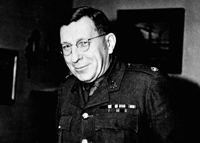
Dr. Frederick Banting
Photo: LAC PA-178289
Frederick Banting was born in 1891 in Alliston, Ontario. During the First World War, Dr. Banting joined the Canadian Army Medical Corps, and served as a medical officer. Just weeks before the armistice, he was wounded in the right arm but continued to treat injured soldiers, earning him the Military Cross. In 1922, he was awarded Canada’s first-ever Nobel Prize for the discovery of insulin.
Banting also conducted medical research for the military during the Second World War. He died in a plane crash in Newfoundland while on a secret scientific mission to England in 1941.
An Aboriginal – Canadian Trailblazer
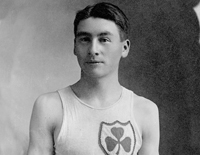
Alexander Decoteau in 1912.
Photo: City of Edmonton Archives EA-10-2072
Alexander Decoteau was born in Saskatchewan in 1887 and moved to Alberta as a young man. A remarkable long-distance runner, he competed in the 1912 Olympics in Stockholm, Sweden. He was also our country’s first Aboriginal-Canadian police officer before enlisting in the army during the First World War.
Private Decoteau won the five-mile race during a military sports day in England and King George V awarded him his personal gold pocket watch as a prize. Tragically, he was killed in October 1917 during the Battle of Passchendaele. It is said that the German sniper who shot him took the watch but Decoteau’s comrades later killed the sniper, recovering the treasured memento and sending it home to Decoteau’s mother.
Music in the Trenches
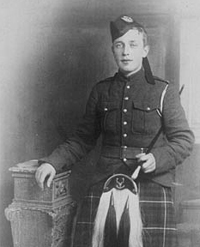
Piper James Richardson
Photo: LAC PA-C-033428
The Canadian military has a long tradition of using music to build morale. During the First World War, playing the bagpipes even earned a British Columbia soldier the Victoria Cross (the highest award for courage).
In October 1916, James Richardson of the Seaforth Highlanders was in action on the Western Front in France. The 20-year-old piper’s company was launching an attack during the Battle of the Somme when the men were held up by thick barbed wire and intense enemy fire. Richardson cooly strode back and forth outside the wire and proudly played his pipes, inspiring his comrades to successfully capture the enemy position.
Richardson later helped in the transport of a wounded comrade and some prisoners away from the fighting. Remembering that he had left his precious pipes behind, Richardson insisted on going back to retrieve them. He was never seen again.
Miraculously, Richardson’s bagpipes were found in the mud of the Somme in 1917. On display in Scotland for decades, they were repatriated and placed on display in the British Columbia Legislature in 2006. Richardson’s pipes had finally come home.
Two Wars – One Ace
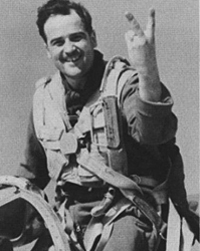
Omer Levesque in the cockpit.
Photo: Public Domain
Omer Levesque was born in Mont-Joli, Quebec in 1920. Early in the Second World War, Levesque joined the Royal Canadian Air Force (RCAF) where he flew Hurricane and Spitfire fighter aircraft. Patrolling over occupied France in November 1941, he shot down a German Focke-Wulf 190, the first kill of this new fighter aircraft by an RCAF pilot. He later shot down three more German fighters during the war.
Levesque was shot down over the French coast in 1942 while battling fighters protecting German warships. He was captured and spent the rest of the war in Stalag Luft III, the German prisoner of war camp made famous by the Hollywood movie, The Great Escape.
Levesque returned to action in November 1950 when he went to Korea on an exchange posting with the United States Air Force. He became the first Commonwealth pilot to shoot down a Chinese Communist MiG-15 fighter. With his total aerial combat victories from the two wars now at five, he became an “ace.”
A Real Life “Band of Brothers”
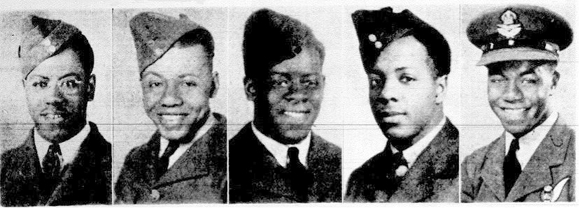
The Carty family of Saint John. Photo: The Telegraph Journal
The military heritage of African-Canadians is long and proud. The Carty family of Saint John, New Brunswick, exemplifies this commitment to service. Albert Carty, a First World War Veteran, and his wife Fannie had five sons who served in the Royal Canadian Air Force (RCAF) during the Second World War.
Adolphus, the oldest, was a flight sergeant and served as an airframe mechanic. William was a flight sergeant who served as an aeronautical inspector. Clyde, a leading aircraftman, served as a firefighter. Donald, an aircraftman second class, was an equipment assistant. erald joined at age 18 and was one of the youngest commissioned officers in the RCAF at age 19. During more than 35 missions, he saw service as a wireless air gunner on Wellington and Lancaster bombers and was wounded in action.
In keeping with family tradition, two younger brothers at home, Robert and Malcolm, were members of the Army and Air Cadets during the war.
A Naval Officer Reached the Stars
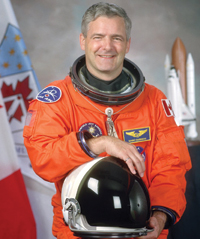
Marc Garneau
Photo: Canadian Space Agency
Marc Garneau was born in Quebec in 1949. He joined the Canadian Navy in 1974, working as a combat system engineer. He designed a simulator and training equipment for the Navy. In 1983, he was selected as one of Canada’s first astronauts, and became the first Canadian in space in 1984.
- Date modified: